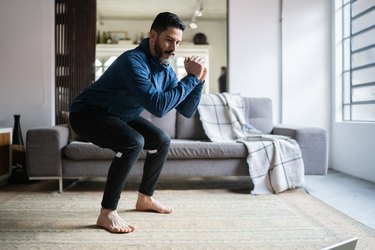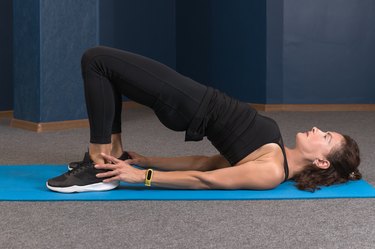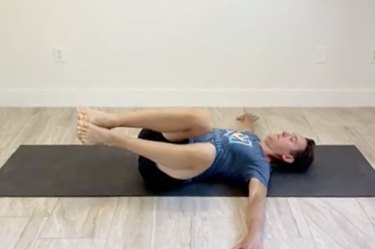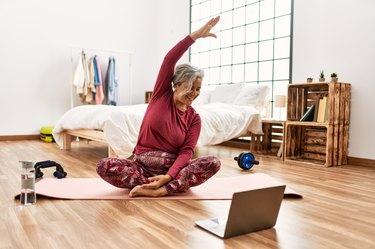
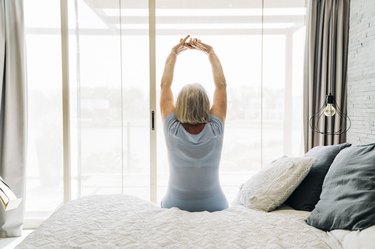

Mobility is one of the keys to life lived well — allowing you to get up, move around and do everything you want (and without pain). But it also happens to be something that can decline through the years.
Fortunately, it's something you have more control over than you might think. Why? Because mobility losses actually have less to do with changing bodies and more to do with changing lifestyles.
Video of the Day
Video of the Day
We are not doomed to frailty just because we grow older if we are willing to stay active and make wellness a priority. Remaining active and living a healthy lifestyle is one of the best things you can do for your present and future self.
Why Mobility Matters for Healthy Aging
In its simplest terms, mobility is how you move. More specifically, it's how well your joints move through their full range of motion, Sabrena Jo, CPT, senior director of science and research at the American Council on Exercise (ACE), tells LIVESTRONG.com.
The value of being able to take a joint through its range of motion (say, extending and flexing an elbow or ankle) is that it supports your ability to move or walk freely and easily. That's critical for functioning well and living independently, according to the National Institute on Aging (NIA).
What does that look like in real life? Examples include reaching into the cupboard for a cup (shoulder), walking up and down stairs (ankle)) and bending down to pick something off the floor (hips and knees), Joe Castelli, DPT, founder of S.P.O.R.T. Physiotherapy and Wellness in New York City tells LIVESTRONG.com.
Overtime, a lack of mobility translates into less independence, as well as a greater risk of falls, disease, loss of function and even death, according to the NIA. Without good joint mobility, you may also feel stiff and achy, and participating in activities or daily tasks will become more difficult. Losing mobility can be a big drag on your quality of life.
Fortunately, improving your range of motion can decrease pain, anxiety, depression and improve the ability to do day-to-day activities and personal-care routines, per an August 2017 study in PLOS ONE.
The bottom line: Preserving and knowing how to regain mobility are critical for healthy aging. And it's never too late to start.
Why Mobility Worsens With Age
Some mobility losses are just a part of getting older. "A natural consequence of aging is the breakdown of collagen, a structure that holds water, which provides fluid and suppleness to joints," Jo says. That makes it harder for joints to access their full range of motion.
Also, as you age, certain conditions, such as hypertension, heart disease and heart failure, diabetes, rheumatoid arthritis and osteoarthritis are also associated with mobility loss, according to a study in the Annals of Medicine in March 2019. Sarcopenia, or age-related muscle loss, can also contribute.
But as far as natural changes with age go, that's about it. (And you can argue that age-related muscle loss isn't a guarantee if you stay active.)
The biggest reason joint range of motion declines with age is because of our habits. Think: If you don't use it, you lose it. Plus, over time, repetitive motions get engrained.
One classic example? Typing at a keyboard. Jo explains that typing shortens the muscles in the front chest. If you're also hunched forward (a common at-your-desk posture), then you are over-stretching the muscles in your back.
"Over the years, if you don't do anything to counteract that habitual activity, the muscles on one side of a joint become chronically shortened and the muscles on the opposite side become chronically lengthened," she says.
For instance, even when you're not at your desk, you might still walk around in the world with that imbalance, contributing to a loss of mobility. The danger is that this can cause wear-and-tear on joints that, long-term can lead to chronic pain.
Finally, if you're not physically active, you're not conditioning your joints to move through their full intended range of motions. This can also cause loss of mobility in older adults, Jo says.
As it stands, 27.5 percent of people globally do not get enough physical activity, according to a September 2018 study in The Lancet Global Health of nearly two million people. (Sufficient physical activity was defined as at least 150 minutes of moderate-intensity or 75 minutes of vigorous-intensity physical activity per week.)
Warning
Natural age-related changes happen gradually over time. If you experience a sudden loss of mobility, immediately seek medical attention.
4 Ways to Preserve (and Improve!) Mobility as You Age

"We are not doomed to frailty just because we grow older if we are willing to stay active and make wellness a priority," says Michelle Rogers, CPT, a certified personal trainer and senior fitness specialist. "Remaining active and living a healthy lifestyle is one of the best things you can do for your present and future self."
Here are the habits that experts want you to stick with:
1. Stay Active
Do what you can to build activity into your day. "You can offset some of those mobility losses due to aging if you just keep moving," Jo says. And that doesn't mean training for a marathon or sweating buckets doing a high-intensity interval workout (though it can!).
Get this: In a February 2021 JAMA Network Open study, older adults who participated in the greatest amounts of daily light-intensity physical activity (walking, gardening and even drying dishes) were up to 40 percent less likely to develop mobility problems over a six-year span compared with those who were less active.
"One of the simplest and best exercises is walking. That's a great place to start," Rogers says.
Schedule daily walks, and choose the time when you're most likely to make it happen (such as in the morning before things pop up in your day or after dinner when you know you can dedicate the time). Start small, Rogers says, and work up to longer sessions until you reach 30 minutes per day. For days when you don't have the time for a full walk, just do what you can. Every bit counts.
2. Mix Up Your Moves
It's great to find a workout you love, but doing the exact same exercises every day isn't ideal for joint mobility. Better are exercise sessions that look different on different days of the week. (Don't worry, you can — and should — repeat your workouts from week to week.)
"A combination of activities — like strength training, cycling, running and yoga — will move your joints in all the ways possible," Jo says.
For instance, she says, if you make all of your workouts cycling ones, you will move joints in a single position, which can cause your hips, back and chest to become tight and achy. You can decrease that risk by opening up the front of your body through strength and yoga.
"If you keep a varied schedule of activities to move your body in different ways, you don't have to worry that much about mobility loss," says Jo.
3. Take Standing Breaks
If you have a desk job, then you're probably spending long periods of time sedentary at your desk. And you might be able to relate to the sensation of getting up after sitting for a while to feel tight and achy.
"One of the ways we can counteract that is to move often," Jo says. If you're at a desk job, that can look like standing up on your feet and/or walking once an hour for five minutes, she recommends.
The earlier you can start this habit the better, but it's never too late. For older adults, those who took more breaks per day — including moving from sitting to standing — were more likely to have better physical function, as assessed by a senior fitness test, according to a January 2015 study in The Journals of Gerontology: Series A.
Standing up to interrupt time spent sitting engages large skeletal muscles and, when consistently performed throughout the day, activates thousands of muscular contractions, the researchers note. Standing up more — no matter your age — is important even if you've done a workout that day.
4. Get Bendy
Stretching that target your shoulders, spine, hips, calves can battle chronic stiffness that plays into mobility losses in older adults, says Jo. Stretching — both with static (bend and hold) stretches as well as dynamic (flowly) ones — is a great opportunity to move your joints in ways they otherwise might not all too regularly.
Many yoga workouts also include a flexibility and mobility component, Jo says.
However you decide to bend and stretch, focus on challenging yourself — but always without pain. Pushing too hard into stretches can damage your joints and contribute to injury. The goal is to feel a gentle, pleasant stretch in your muscles. If something doesn't feel good, listen to your body and pull back a bit or avoid that stretch altogether.
- National Institute on Aging: “Maintaining mobility and preventing disability are key to living independently as we age.”
- PLOS ONE: "The association between observed mobility and quality of life in the near elderly."
- Annals of Medicine: "Chronic diseases and objectively monitored physical activity profile among aged individuals – a cross-sectional twin cohort study."
- The Lancet Global Health: "Worldwide trends in insufficient physical activity from 2001 to 2016: a pooled analysis of 358 population-based surveys with 1.9 million participants."
- JAMA Network Open: "Evaluation of Light Physical Activity Measured by Accelerometry and Mobility Disability During a 6-Year Follow-Up in Older Women."
- The Journals of Gerontology: "Breaking-up Sedentary Time Is Associated With Physical Function in Older Adults."
